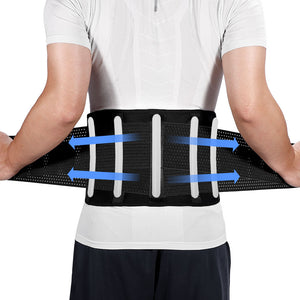How Does Rotator Cuff Brace Help Shoulder Restore Normal Function?

The rotator cuff, as an essential structure of the shoulder joint, is responsible for maintaining stability and movement of the shoulder joint.
However, rotator cuffs are highly injury-prone. There are a lot of person suffering from rotator cuff injuries who experience a visible reduction in their ability to perform routine tasks.
To help restore normal function to the shoulder joint, rotator cuff braces have been developed.
This article will talk about the specific impact of rotator cuff injuries on people's daily lives and study how shoulder support for the rotator cuff can assist in restoring normal shoulder function.

Basics of the Rotator Cuff
The rotator cuff is a collection of muscles and tendons that envelop the shoulder joint. It plays a role in stabilizing the shoulder and allows the arm to perform various movements.
Without this structure well in place, simple activities like lifting the arm, rotating it, and performing overhead activities that require a combination of strength and precision become impossible.
Causes of Rotator Cuff Injuries
- Sports Injuries: Sportsmen who use their shoulders extensively often damage their rotator cuffs. It is expected to see athletes in baseball, tennis, cricket, or swimming experience these injuries due to the intense use of the shoulder.
- Repetitive Strain Injuries: Even if you are not a sportsman, you are still exposed to this injury in multiple ways. It can happen during any daily life activity that involves constant shoulder use. Painters, carpenters, and even individuals involved in frequent lifting or activities with repetitive overhead motions are at risk of developing these injuries.
- Age-related Wear and Tear: As part of the natural aging process, the rotator cuff tendons gradually degenerate and weaken. This wear and tear increases the susceptibility to tears and can expose you to this dangerous injury.
Impact of Rotator Cuff Injuries on Daily Life
While it may not look dangerous from the outside, the rotator cuff injury guarantees to stop your physical movement to a great extent.
Here is how:
- Limitation of Movement
Affected individuals get so restricted in their daily life activities that they even struggle to brush their hair, reach for items on high shelves, or even dress. And these are only the basic activities that you cannot perform with this injury. Apart from these movements, all other activities, like playing tennis, swimming, and fitness exercises that require shoulder movements, become impossible.
This means that your whole independence will be at stake the moment you suffer from this injury.
-
Pain Effects
What about the constant pain that comes with rotator cuff injury and makes you scream at times? This discomfort can become so severe that you can even face a wave of pain while resting, let alone trying to work.
The persistent injury will also push you into the habit of taking pain relief medications that have their own set of side effects. What's more is that chronic pain has psychological effects, including mood swings, depression, and decreased motivation, which will further diminish your life quality.

Role of Rotator Cuff Brace
However, the good news is that a rotator cuff brace will act as a life savior in the management and rehabilitation of these injuries.
The rotator cuff brace promises to provide support and stabilization to your shoulder, which will aid in your recovery.
Here are the key benefits of using a rotator cuff brace:
✔ Reducing Pain
The rotator cuff brace evenly distributes weight and pressure, reducing stress on the injured or affected area to relieve pain. In addition, the shoulder compression brace can effectively immobilize the shoulder, preventing further injury and increased pain by limiting the range of motion of the shoulder.
✔ Improving Mobility
A rotator cuff brace provides stable support for the shoulder, permitting controlled and supported movement. Therefore, the shoulder can gradually adapt and improve mobility during the recovery process.
✔ Promoting Healing
The support and compression provided by a rotator cuff brace can promote the healing process. It helps by reducing inflammation, providing gentle immobilization, and allowing the injured tissues to rest and recover. The shoulder compression sleeve can also enhance blood circulation, which helps transmit nutrients and oxygen to the injured area, supporting tissue repair and recovery.
Considerations for Using a Rotator Cuff Brace
While shoulder support rotator cuff brings a lot of advantages with them, there are some important guidelines to follow:
- Wear it Correctly
Only the correct application of a compression sleeve for the shoulder will bring you out of trouble. Always ensure that the rotator cuff brace fits snugly around the shoulder without causing constriction or discomfort. Adjust the straps to a level that supports the shoulder but does not impair circulation or pinch the skin.
- Moderate Use
Although a rotator cuff brace is extremely beneficial, over-reliance on it can lead to muscle atrophy or dependency on the support. So do not use it too much that you become dependent on it for relief.
- Regular Adjustment
As the healing process progresses, the needs of the shoulder will change. The key here is to regularly adjust the tightness and configuration of the shoulder compression brace to provide the appropriate level of support.
- Follow Medical Advice
Some injuries can come with hidden complications, which are best treated only after visiting a medical professional. Medics can give you a broader healing plan, which includes a combination of medicines, therapy, and a shoulder brace for rotator cuff tears.
Fivali Shoulder Cuff Brace Promote Recovery Ice Pack Insertion – 1 Pack
Fivali Shoulder Cuff Brace Promote Recovery Ice Pack Insertion – 1 Pack is one of the best shoulder support braces that will deal with shoulder rotator cuff injuries:
- Compression
This rotator cuff brace provides gentle compression to help reduce swelling and bruising of the soft tissues of the shoulder, which is common after a rotator cuff injury. Reduced swelling helps relieve pain and promotes faster recovery.
- Stability
Stability is an important factor in the recovery process from a rotator cuff injury. The rotator cuff brace offers proper stability to prevent further damage, supporting the damaged soft tissues to heal safely.
- Specific Pockets Designed for Ice Packs
Cold therapy is a standard method of managing pain and swelling after a rotator cuff injury. The straps of this rotator cuff brace come with specific pockets designed to accommodate ice packs, allowing for easy application of cold therapy to help reduce pain and inflammation.

Other Ways to Recover from Rotator Cuff Injury
Apart from shoulder compression brace, there are some other handy ways to get rid of rotator cuff injuries.
- Physical Therapy
A well-designed physical therapy program will strengthen your shoulder muscles and improve your flexibility. These exercises also increase your range of motion, allowing you to return to your original form.
- Medical Interventions
Depending on the severity of the injury, various medical interventions may be necessary. These interventions include anti-inflammatory medications, corticosteroid injections, and advanced treatments like surgical repair that are only done in extreme cases.
- Daily Life Modification
Some quick changes in your daily routine also promise impressive results that can eventually heal shoulder injuries. For instance, avoid activities that reduce strain on shoulders, use ergonomic tools, and avoid movements that exacerbate the injury.
- Psychological Support
Chronic pain and restrictions caused by rotator cuff injuries can affect mental health. Receiving psychological support such as psychotherapy or counseling is always a helpful approach. We have impressed fitness geeks with its wide variety of body braces that will help you avoid different injuries. If you are struggling with a rotator cuff injury, consider our rotator cuff brace for effective support and recovery. Visit our website and take a step towards a pain-free and active lifestyle with Fivali.
-
Posted in
Joint, Recovery, Shoulder pain













